How to Make Durian Sticky Rice? 5 Easy Steps!
Durian Sticky Rice, a classic Southeast Asian dessert, is a perfect blend of creamy durian pulp and sweet sticky rice topped with savory coconut cream.
It’s a straightforward recipe that involves steaming glutinous rice, mixing it with coconut milk, and serving it with durian and additional coconut sauce.
This dish is sure to satisfy those who crave the unique flavor of durian paired with the comforting taste of sticky rice.
To make Durian Sticky Rice, you need:
For example, a common ratio used in the recipe is 2 cups of glutinous rice to 1 cup of coconut milk, which ensures the rice is moist but not overly wet.
Enjoy a tropical dessert experience with the sumptuous combination of sweet sticky rice and the bold flavor of durian.
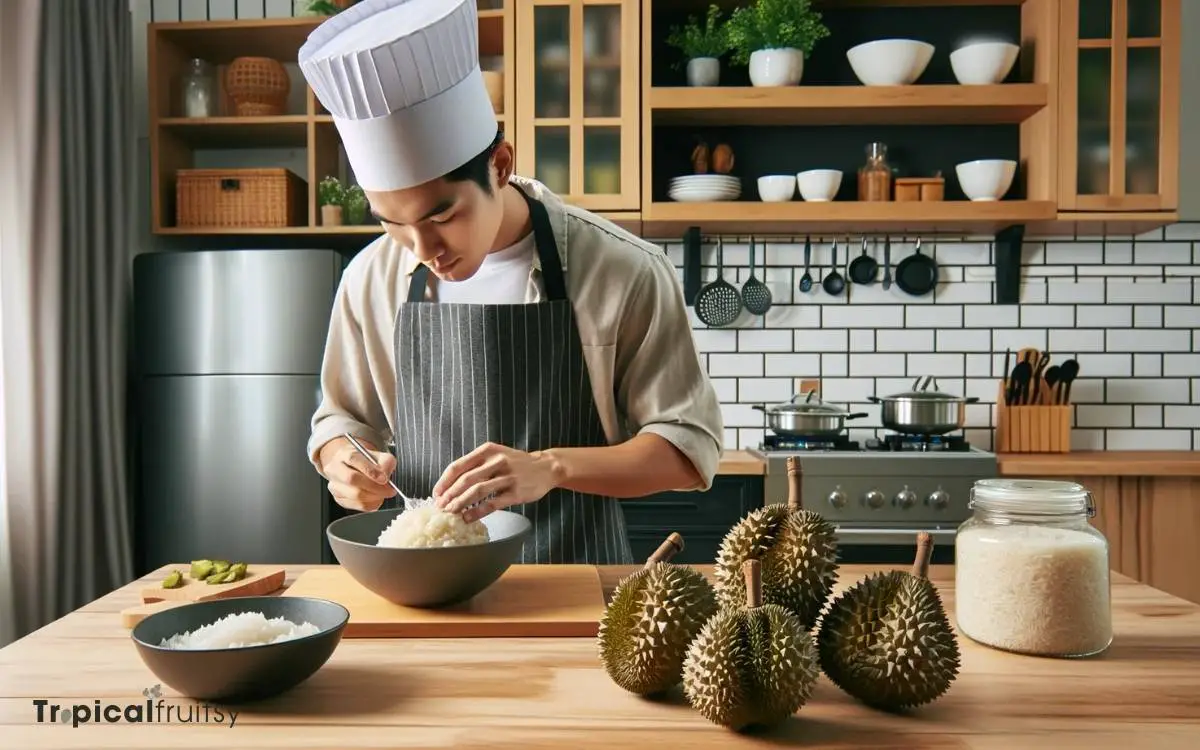
Key Takeaway
Ingredients and Tools Needed
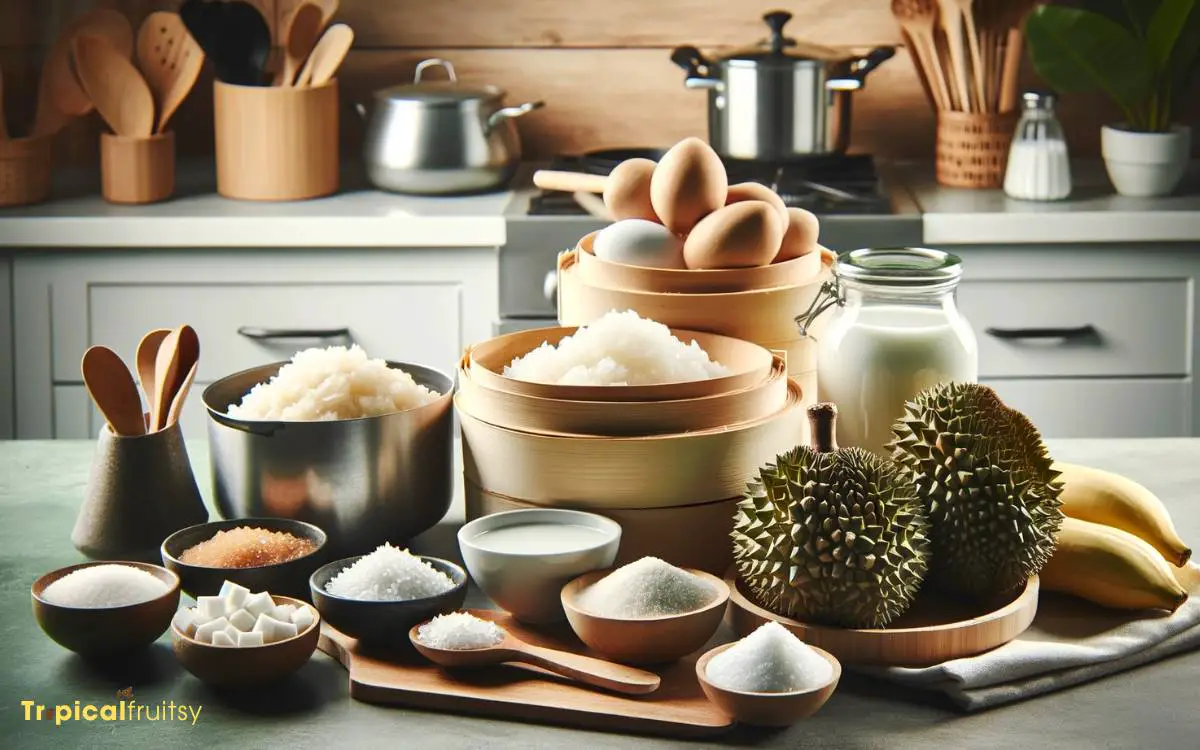
To prepare Durian Sticky Rice, you will require specific ingredients such as glutinous rice, ripe durian flesh, coconut milk, sugar, and salt, along with tools including a steamer, a mixing bowl, and a serving dish.
The glutinous rice, central to this dish, should be of the highest quality, chosen for its ability to absorb flavors and maintain a sticky, yet firm texture upon cooking.
Select durian flesh that is sweet and creamy, ensuring it imparts the characteristic rich taste durian lovers seek. Coconut milk used should be fresh and unsweetened to balance the fruit’s natural sugars.
Sugar, preferably palm for its subtle caramel notes, and a pinch of salt are essential to enhance the overall flavor profile.
The tools, specifically the steamer, must allow for even cooking of the rice, while the mixing bowl should facilitate gentle folding of the ingredients, preserving the delicate textures.
Lastly, the serving dish should complement the presentation, making it as visually appealing as it is indulgent to the palate.
Step 1: Preparing the Sticky Rice
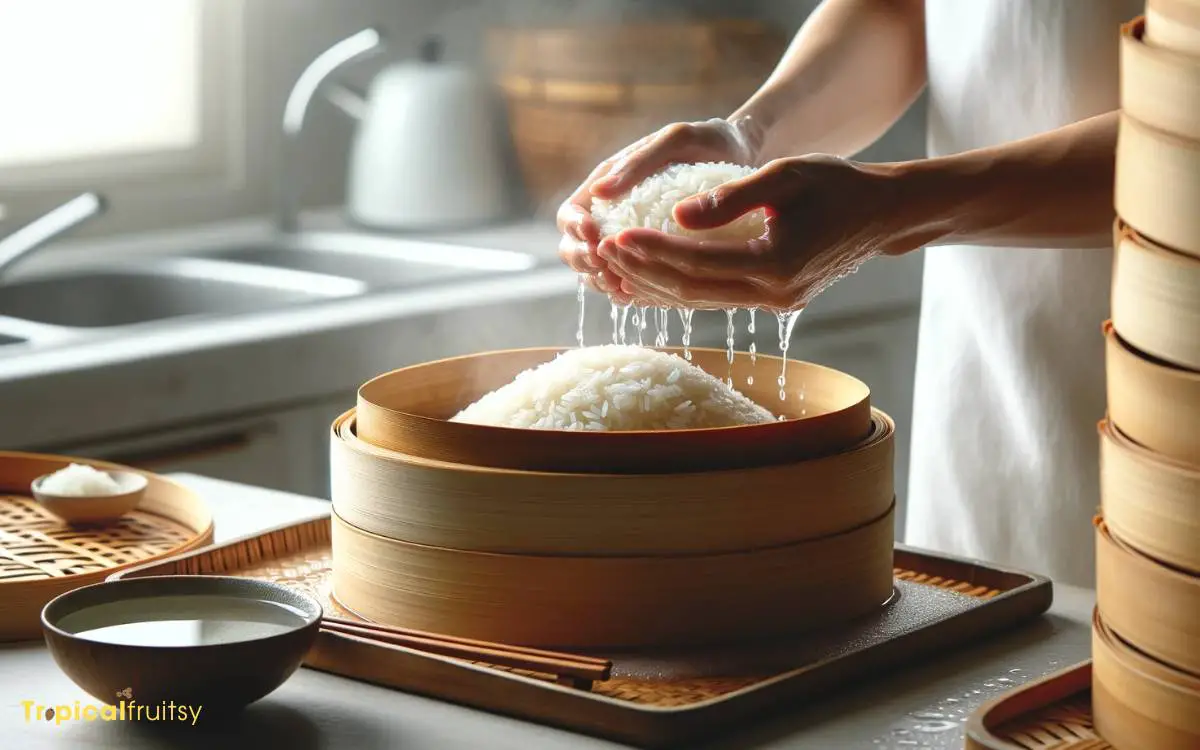
The foundation of the dish lies in the meticulous preparation of the sticky rice, which begins with an ample soaking period to ensure grains swell to their ideal plumpness.
The manner in which the rice is then steamed is pivotal, requiring a delicate balance of time and temperature to coax out the quintessential sticky texture.
Mastering this process is crucial, as the rice must embody a soft, chewy consistency to harmoniously complement the creamy richness of the durian.
Rice Soaking Time
Before cooking, the sticky rice must be soaked in water for at least four hours to ensure proper texture and flavor absorption.
This age-old practice is critical in traditional Southeast Asian cuisines, where sticky rice is a staple.
Proper soaking allows the grains to swell and soften, which is essential for achieving the desired stickiness and chewiness that complements the rich, pungent flavor of durian.
- Rinse: Begin by thoroughly rinsing the rice in cold water to remove any impurities and excess starch.
- Submerge: Place the washed rice in a deep bowl and cover it with water by at least two inches.
- Rest: Allow the rice to rest undisturbed, fully submerged, to promote even hydration.
Understanding the importance of this step sets the foundation for successful cooking, which we will explore in the following section.
Cooking Method
After soaking, the sticky rice is steamed until tender, a crucial step that preserves its distinct texture and allows it to absorb the flavors of the durian.
This process harkens back to a time-honored culinary tradition where the delicate grains are treated with the utmost respect, ensuring each morsel is perfectly cooked.
A bamboo steamer is often used to achieve the desired result, allowing the rice to breathe and cook evenly.
| Step | Equipment | Note |
|---|---|---|
| 1. | Bamboo Steamer | Ensures even cooking and imparts a subtle aroma. |
| 2. | Cheesecloth | Prevents rice from sticking to the steamer. |
| 3. | Pot of Water | Provides the steam required for cooking. |
The rice should be carefully monitored and steamed to a point where it retains a slight bite, indicative of its glutinous nature, ready to be lavished with the creamy durian concoction.
Achieving Perfect Texture
One must ensure that the sticky rice is soaked for an adequate duration, typically overnight, to attain its characteristic chewy texture before steaming.
The preparation of sticky rice is a meticulous process that lays the foundation for the delightful pairing with the pungent durian.
To guide you through the essentials of crafting the perfect sticky rice, consider the following:
- Rinse the rice in cold water several times to remove excess starch, which can result in a gummy texture.
- Soak the rice in an ample amount of water to ensure each grain absorbs moisture evenly.
- Choose a traditional bamboo steamer for cooking, as it allows the rice to cook evenly and imparts a subtle, woody aroma that complements the durian’s intensity.
Step 2: Selecting and Prepping Durian
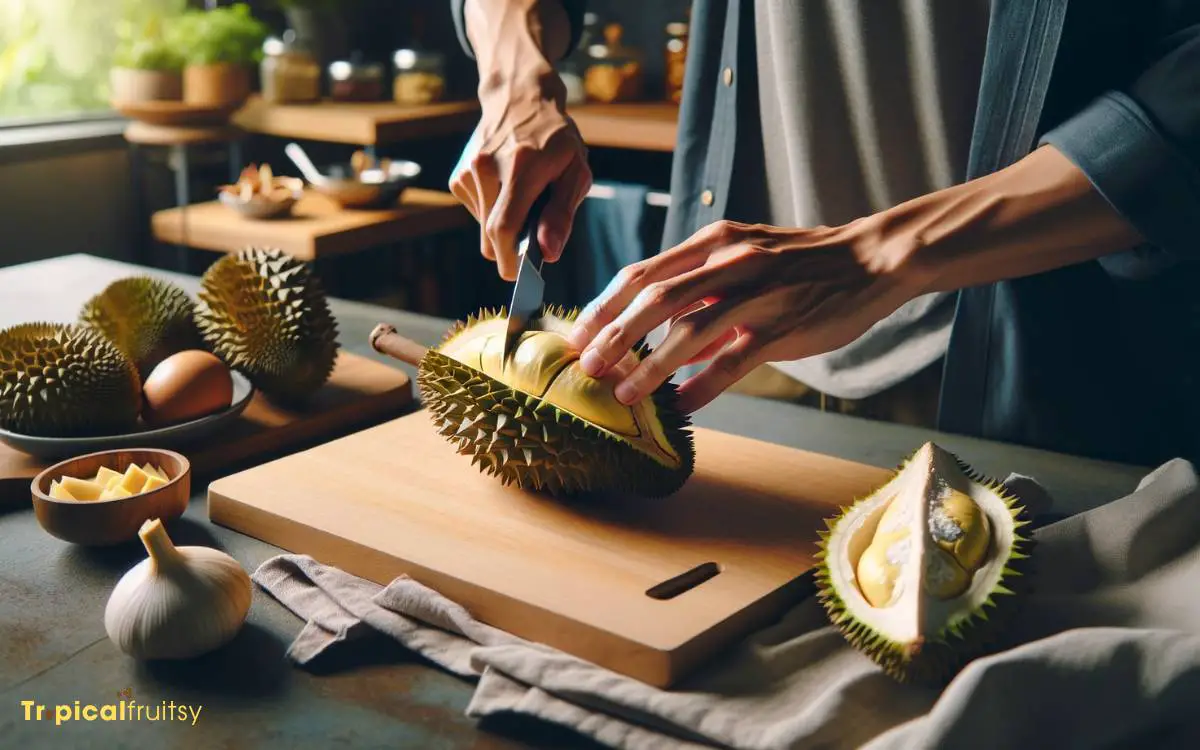
The selection of a ripe durian is pivotal to the authenticity and flavor of the sticky rice dish. One must look for a fruit with a firm stem, a strong aromatic presence, and a slight give under pressure.
Once a suitable durian is acquired, the art of cutting must be approached with respect to tradition. This involves a careful incision along the seams of its formidable husk.
The meticulous removal of seeds is an integral step that requires precision. This step ensures that the creamy flesh can be extracted without compromising its texture or integrity.
Ripe Durian Identification
Selecting a ripe durian is crucial for the flavor profile of durian sticky rice, involving careful examination for firmness, aroma, and stem condition.
To identify a ripe durian, one must engage in a ritual as old as the fruit itself, looking beyond the formidable spiky husk to discern the treasure within.
Here are key indicators to ensure the selection of a ripe durian:
- Firmness: Gently press the outer shell. A ripe durian yields slightly to pressure, indicating soft, creamy flesh inside.
- Aroma: Sniff near the stem. A mature durian emits a strong, distinctive smell that is rich and sweet.
- Stem Condition: Observe the stem; it should appear big and solid. A dry, cracked stem suggests the durian has aged on the branch and is likely ripe.
Durian Cutting Techniques
Having selected a ripe durian, the next critical step involves mastering precise cutting techniques to access the luscious fruit needed for your sticky rice dish.
Begin by donning gloves to protect your hands from the durian’s formidable spikes. Place the durian stem side down on a sturdy surface. Look for the natural seams running along the fruit’s husk — these are your guide.
With a sharp knife, make a shallow incision along one seam then gently pry the husk apart using your hands. The goal is to expose the chambers where the creamy, fragrant flesh nestles.
Once opened, remove the sections of fruit carefully, avoiding any hard, inedible seeds. The durian should yield easily if it is truly ripe, revealing the treasure within for your culinary delight.
Removing Durian Seeds
Upon extracting the durian flesh, meticulously remove the large seeds to ensure a smooth blend with the sticky rice.
The process of seed removal is paramount in achieving the desired consistency and flavor profile of your durian sticky rice. It is a ritual of patience and respect for the ingredients which characterizes the traditional approach to this delicacy.
To prepare the durian for your dish, follow these steps:
- Gently pry the plump, creamy lobes of durian flesh from their thorny encasement.
- With a tender touch, sift through the flesh to locate the oblong seeds.
- Using a careful motion, extract the seeds, preserving the integrity of the surrounding fruit.
Having prepared the durian to perfection, we now turn our attention to the art of cooking the sticky rice.
Step 3: Cooking the Sticky Rice
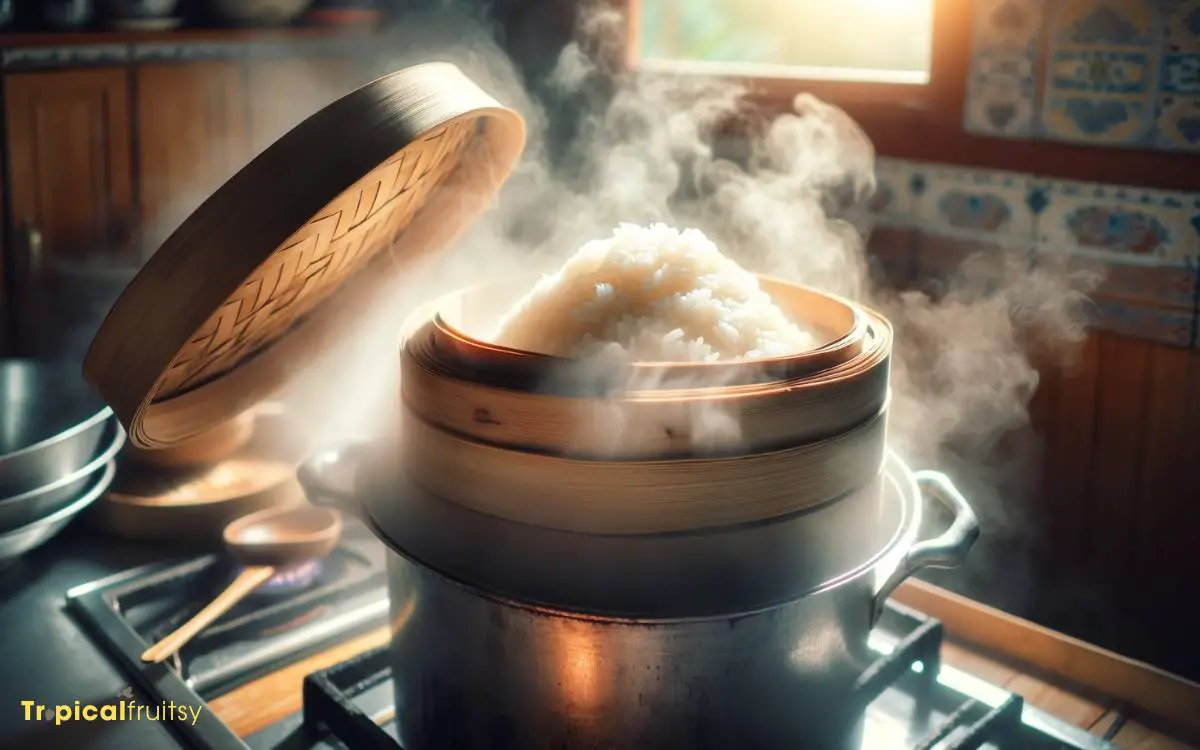
Preparation of the sticky rice is a crucial step in creating the foundation for the durian sticky rice dish.
Begin by rinsing the grains until the water runs clear, washing away excess starch, which is essential for achieving the perfect texture.
Soak the rice in ample water for at least four hours, or better yet, overnight, to ensure the grains are plumped and ready for steaming. Drain the rice and place it in a traditional bamboo steamer lined with cheesecloth.
Steam over a pot of boiling water, ensuring the steam is distributed evenly, for about 30 minutes or until the rice becomes tender and translucent.
Once cooked, the sticky rice must be kept warm and pliable, ready to be married with the creamy richness of the coconut sauce in the next step of our culinary journey.
Step 4: Making the Coconut Sauce
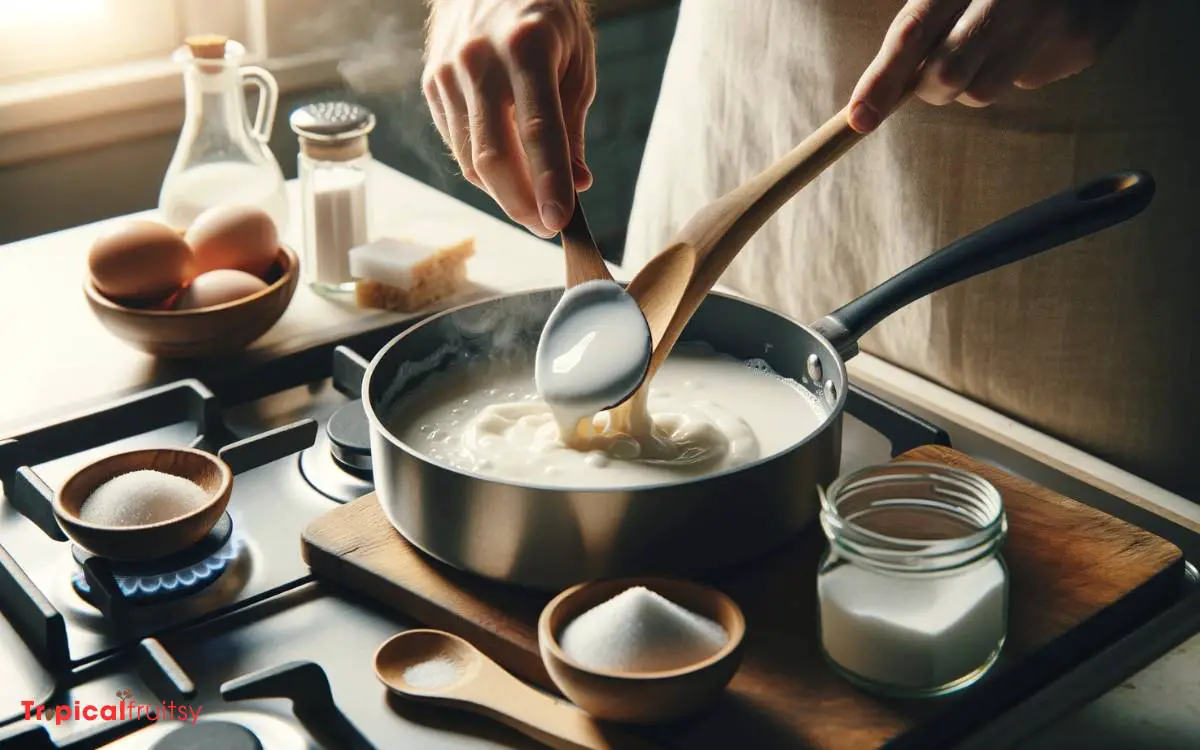
Why is the coconut sauce integral to the durian sticky rice dish?
The sauce serves as a harmonious counterpoint to the potent aroma of durian, enveloping the sticky rice with a velvety layer of sweetness and richness that accentuates the fruit’s complex flavor.
It is the silken ribbon that ties the components of the dish into a cohesive, indulgent experience.
To craft this essential element:
- Simmer: Gently heat coconut milk to avoid curdling, allowing the sugars to meld with the delicate tropical essence.
- Season: Balance the sweetness with a touch of salt, creating a sublime contrast that elevates the sauce’s profile.
- Thicken: Add a slurry of tapioca starch to achieve a luxurious consistency that drapes beautifully over the sticky rice.
Step 5: Assembling and Serving
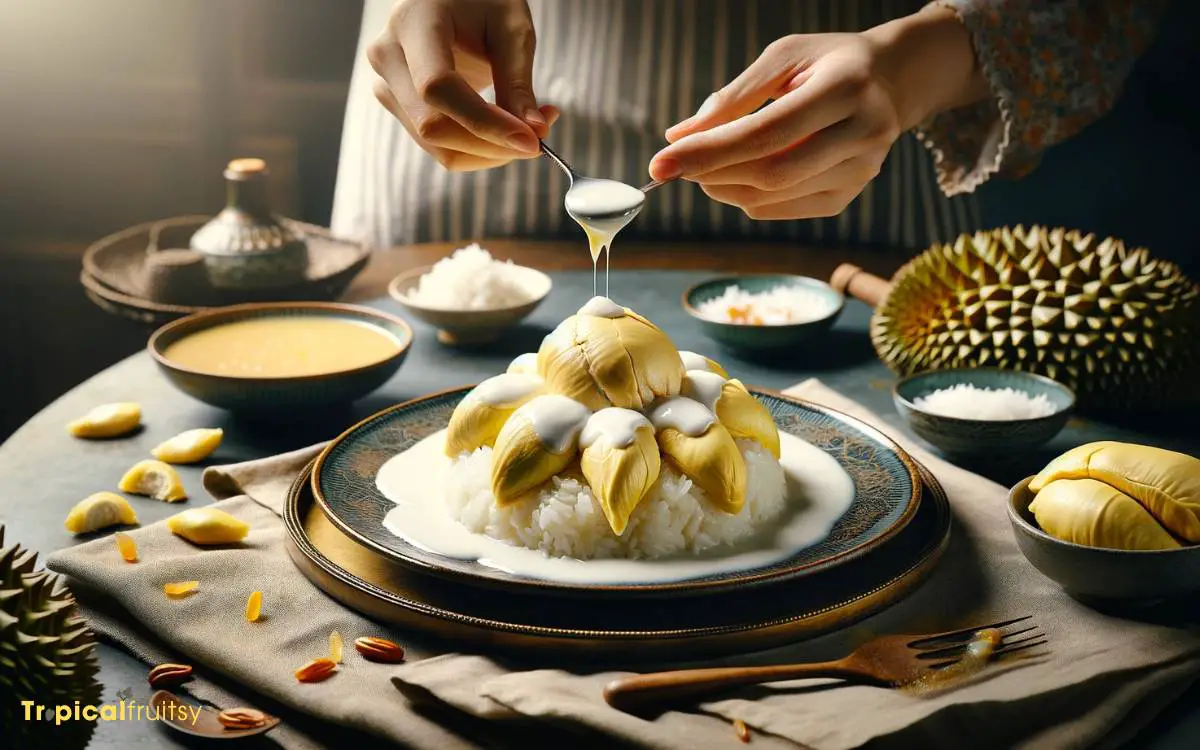
Having prepared the coconut sauce, the next step in creating durian sticky rice is to expertly combine the ingredients for serving.
Begin by arranging a bed of warm, fragrant sticky rice on a serving dish. This rice should be tender yet hold its shape, embodying the perfect canvas for our rich toppings.
Carefully select luscious segments of durian, ensuring they are ripe and aromatic, and place them atop the rice. The potency of durian’s presence is revered, a delicacy that commands both attention and respect.
Finally, drizzle the sweet, creamy coconut sauce over the durian and rice, allowing it to cascade down the sides and pool gently at the base.
This sauce should cloak the components in a velvety embrace, uniting the flavors. Serve this exquisite ensemble immediately, to be enjoyed in its most sublime state.
Conclusion
In the finale of this exquisite culinary journey, the harmonious blend of creamy durian and fragrant sticky rice reaches its zenith.
Each grain of rice is tenderly swathed in the velvety embrace of coconut sauce, evoking a tapestry of tropical aromas.
This dish, reminiscent of Southeast Asian heritage, offers a symphony of textures and flavors that dance upon the palate, leaving an indelible impression of the region’s rich gastronomic tapestry.






